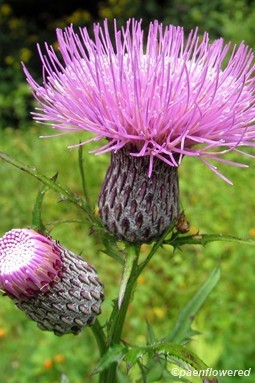Cirsium muticum
Mostly spinesless thistle growing in swamps and bogs
Cirsium muticum swamp thistle
This native, biennial species of thistle has a hollow flowering stem that rises from the first year rosette of long-stalked deeply cut leaves. Unlike some thistles the stems of this species have no spines. The stem leaves of the second year are similar to each other, but are progressively smaller towards the top of the stem. In the second year the plant can grow up to ten feet tall but is usually smaller. The underside of the leaves often has webby fibers that thin out with age. The lobes of the leaves are not usually symmetrical and have short spines.
The flower heads are often clustered and rose-purple in color. The flower head is composite and made up of many individual disk florets that can be up to 1.1 inches long. There are no ray florets. The floral bracts that support the flower head are not tipped with spines but sticky and cobwebby. This is a key trait for identifying this species, and distinguishing it from similar thistle species in this area. There is usually a leafy bract beneath the flower head that is similar in form to the stem leaves. Long-tongued bees and butterflies are the primary pollinators, coming for the nectar produced by the flowers.
The fruit forms with tufts of white hair to help wind distribution. As its common name indicates, it is often found in swamps, wet woods or thickets. It grows throughout eastern North America. The flowering period is July to September. The swamp thistle is the host plant for the swamp metalmark butterfly and the flower is the only source of food for the larva of this insect. The plant is sometimes used in flower arrangements. It is also grown in ornamental gardens because it does not spread aggressively. The spiny leaves may deter browsing mammals. This species is also called the marsh thistle, dunce-thistle, or horsetops.
Habitat & Range
Frequent in swamps, bogs, stream banks, and wet meadows.
Present throughout the state, except at the highest elevations.
Range: Eastern North America
| EMP: | OBL |
|---|---|
| NCNE: | OBL |
Phenology
Flowers July to September.
Plant Codes
S-rank: No rank
G-rank: G5 (Secure)





Comments
Have you spotted this plant in your area? We'd love to hear about your experience! Share your comments or questions about the plant below. Comments are moderated before posting.